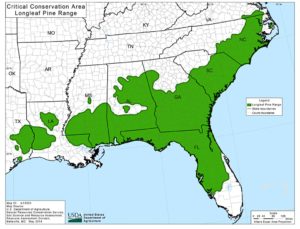Wetland Preserve was originally owned by a large timber company, Plum Creek. This company merged with Weyerhaeuser in 2016. Our family purchased the first 3400 acres of land from Plum Creek before the merger in 2009 and then a second purchase was made in 2015 for 325 acres. Most of the land falls under the category of “Mesic Flatwoods”.
(If you would like a definition of Mesic flatwoods follow this link https://preserve.unf.edu/files/pdf/Slough_Natural_Communities.pdf)
The areas that are considered Creek Swamps or Sand Hill, and have different soil flora and fauna to some extent, are mostly held outside of the forestry envelope. This means that barring any natural calamity these areas are not harvested or disturbed in any way. Sections of the Flatwoods that are suitable are being reforested with longleaf pine and the rest of the planted pine stands that are being harvested are managed under a “long rotation” management regime. Long rotation management means that we let the trees stand (as long as they are healthy) past the optimum economic harvest age, with the exception of thinning. This practice adds non-timber value including wildlife habitat, better carbon storage and the ability to create habitat for old growth dependent species such as the Red-Cockaded Woodpecker.
If you come out to visit us you will get the chance to see touch hear and maybe even taste (if the wild berries are in season!) some of the plants and animals that make Wetland Preserve their home. Here is a list of a few that you are likely to spot!
- White Tailed Deer
- Long Leaf Pine
- Gopher Tortoise
- Pygmy Rattlesnake
- Carnivorous plants – Sundew and Pitcher Plant
- Crayfish
- Bobwhite Quail
- Turkey
Just to name a few !
Into the Past …
Look at the map and imagine the enormity of the forest depicted. A forest extending from costal Virginia, south to central Florida and then west to Texas with it’s northern edged being the Appalachian Mountains. Now imagine that forest being comprised to the greatest extent of giant trees, many hundreds of years old. These trees were spaced , not as we see our Southern Forests today, tightly packed and with dense vegetation surrounding them, but rather spread out such that they looked like more park-like then anything else.
If you can imagine that then you have some idea of what William Bartram saw and described as he wandered the south 200+ years ago.

